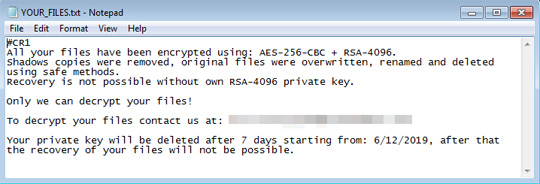Ransom.Win32.PURELOCKER.A
Ransom:Win32/PureLocker!MSR (MICROSOFT); TR/PureLocker.B (ANTIVIR)
Windows


Threat Type: Ransomware
Destructiveness: No
Encrypted: No
In the wild: Yes
OVERVIEW
This Ransomware arrives on a system as a file dropped by other malware or as a file downloaded unknowingly by users when visiting malicious sites.
It drops files as ransom note. It avoids encrypting files with the following file extensions.
TECHNICAL DETAILS
Arrival Details
This Ransomware arrives on a system as a file dropped by other malware or as a file downloaded unknowingly by users when visiting malicious sites.
Installation
This Ransomware adds the following processes:
- wmic shadowstorage SET MaxSpace=337000000 → resizes the maximum amount of storage space that can be used for shadow copy storage
It adds the following mutexes to ensure that only one of its copies runs at any one time:
- Global\{random characters}
Dropping Routine
This Ransomware drops the following files:
- {Malware Path}\dbg.txt → contains list of files it was unable to encrypt
Ransomware Routine
This Ransomware avoids encrypting files with the following strings in their file name:
- bootmgr
- bootsect.bak
- dbg.txt
- iconcache.db
- ntldr
- ntuser.dat
- thumbs.db
- your_files.txt
It avoids encrypting files found in the following folders:
- $Recycle.Bin
- Boot
- Microsoft
- Mozilla
- MSOCache
- Packages
- Python27
- Recycler
- System Volume Information
- Thunderbird
It appends the following extension to the file name of the encrypted files:
- .CR1
It drops the following file(s) as ransom note:
- {Encrypted Directory}\YOUR_FILES.txt

It avoids encrypting files with the following file extensions:
- .qm
- .dll
- .exe
- .ini
- .sys
- .lib
- .msg
- .ocx
- .log
- .url
- .lnk
- .cmd
- .bat
- .etl
- .ico
- .cpl
- .wpl
- .com
- .inf
- .msi
- .mui
- .hxw
- .hxh
- .oca
- .dmp
- .tmp
- .chm
- .hlp
- .cr1
- .readme
- .manifest
- .search-ms
- .appref-ms
- .library-ms
- .searchconnector-ms
- .old
SOLUTION
Step 1
Before doing any scans, Windows 7, Windows 8, Windows 8.1, and Windows 10 users must disable System Restore to allow full scanning of their computers.
Step 2
Note that not all files, folders, and registry keys and entries are installed on your computer during this malware's/spyware's/grayware's execution. This may be due to incomplete installation or other operating system conditions. If you do not find the same files/folders/registry information, please proceed to the next step.
Step 3
Search and delete this file
- {Malware Path}\dbg.txt
- {Encrypted Directory}\YOUR_FILES.txt
Step 4
Scan your computer with your Trend Micro product to delete files detected as Ransom.Win32.PURELOCKER.A. If the detected files have already been cleaned, deleted, or quarantined by your Trend Micro product, no further step is required. You may opt to simply delete the quarantined files. Please check the following Trend Micro Support pages for more information:
Step 5
Restore encrypted files from backup.
Did this description help? Tell us how we did.

